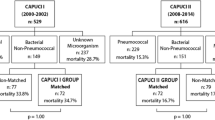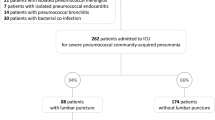Abstract
Purpose
The aim of this quality control study was to assess the time to initial diagnostic procedures and the time to the first dose of antibiotics in patients with pneumococcal bacteremia, and to investigate whether the timeliness of these interventions influenced outcome.
Methods
We retrospectively studied patient characteristics, chronological sequence of diagnostic and therapeutic steps, and the course of disease of all patients with pneumococcal bacteremia at a Swiss university hospital between 2003 and 2009, and we analyzed associations between these factors and the length of hospital stay (LOS) and mortality.
Results
A total of 102 episodes of pneumococcal bacteremia in 98 patients were analyzed, of whom 15.7% died during hospitalization. The median time (interquartile range [IQR]) to the first antibiotic dose was 4.0 (2.0–5.9) h, and the median times (IQR]) to blood cultures, chest radiograph, lumbar puncture, and brain computed tomography (CT) scan or magnetic resonance imaging (MRI) were 1.4 (0.5–3.3), 2.5 (1.2–4.2), 4.2 (2.7–7.2), and 2.3 (0.6–6.2) h, respectively. The time to diagnostic procedures and therapy were not associated with LOS or death. Risk factors for death in the univariable analysis were: Charlson comorbidity index [odds ratio [OR] (95% confidence interval) per unit increase, 1.3 (1.1–1.6)], neutropenia [OR 10.1 (2.0–51.0)], human immunodeficiency virus (HIV) infection [OR 3.9 (1.1–13.8)], chronic respiratory disease [OR 4.4 (1.2–16.0)], chronic liver disease [OR 3.2 (1.0–9.7)], smoking [OR 3.8 (1.1–13.5)], injection drug use [OR 9.7 (1.5–63.7)], and antibiotic therapy within 6 months before admission [OR 4.0 (1.3–12.5)]. The multivariable analysis revealed age >60 years (P = 0.048) and alcoholism (P = 0.009) as risks for prolonged LOS.
Conclusions
The outcome of pneumococcal bacteremia may be more influenced by patient characteristics than by minor differences in the timeliness of initial diagnostic and therapeutic measures within the first several hours after hospital admission.


Similar content being viewed by others
References
Altclas J, Salgueira C, Di Martino A. Pneumococcal bacteremia in a single center in Argentina. Int J Infect Dis. 2004;8:53–8.
Fariñas-Alvarez C, Fariñas MC, García-Palomo JD, González-Ruiz M, Fernández-Mazarrasa C, Parra JA, et al. Prognostic factors for pneumococcal bacteremia in a university hospital. Eur J Clin Microbiol Infect Dis. 2000;19:733–41.
Ho PL, Que TL, Ng TK, Chiu SS, Yung RW, Tsang KW. Clinical outcomes of bacteremic pneumococcal infections in an area with high resistance. Eur J Clin Microbiol Infect Dis. 2006;25:323–7. doi:10.1007/s10096-006-0139-6.
Laurichesse H, Romaszko JP, Nguyen LT, Souweine B, Poirier V, Guólon D, et al. Clinical characteristics and outcome of patients with invasive pneumococcal disease, Puy-de-Dôme, France, 1994–1998. Eur J Clin Microbiol Infect Dis. 2001;20:299–308.
Trampuz A, Widmer AF, Fluckiger U, Haenggi M, Frei R, Zimmerli W. Changes in the epidemiology of pneumococcal bacteremia in a Swiss university hospital during a 15-year period, 1986–2000. Mayo Clin Proc. 2004;79:604–12.
Berjohn CM, Fishman NO, Joffe MM, Edelstein PH, Metlay JP. Treatment and outcomes for patients with bacteremic pneumococcal pneumonia. Medicine (Baltimore). 2008;87:160–6.
Meehan TP, Fine MJ, Krumholz HM, Scinto JD, Galusha DH, Mockalis JT, et al. Quality of care, process, and outcomes in elderly patients with pneumonia. JAMA. 1997;278:2080–4.
Waterer GW, Kessler LA, Wunderink RG. Delayed administration of antibiotics and atypical presentation in community-acquired pneumonia. Chest. 2006;130:11–5.
Winstein CJ. Neurogenic dysphagia. Frequency, progression, and outcome in adults following head injury. Phys Ther. 1983;63:1992–7.
Frei CR, Restrepo MI, Mortensen EM, Burgess DS. Impact of guideline-concordant empiric antibiotic therapy in community-acquired pneumonia. Am J Med. 2006;119:865–71.
Chaudhuri A, Martinez-Martin P, Kennedy PG, Andrew Seaton R, Portegies P, Bojar M, et al. EFNS guideline on the management of community-acquired bacterial meningitis: report of an EFNS Task Force on acute bacterial meningitis in older children and adults. Eur J Neurol. 2008;15:649–59.
Houck PM, Bratzler DW. Administration of first hospital antibiotics for community-acquired pneumonia: does timeliness affect outcomes? Curr Opin Infect Dis. 2005;18:151–6.
Garnacho-Montero J, García-Cabrera E, Diaz-Martín A, Lepe-Jiménez JA, Iraurgi-Arcarazo P, Jiménez-Alvarez R, et al. Determinants of outcome in patients with bacteraemic pneumococcal pneumonia: importance of early adequate treatment. Scand J Infect Dis. 2010;42:185–92.
Cusini A, Rampini SK, Bansal V, Ledergerber B, Kuster SP, Ruef C, et al. Different patterns of inappropriate antimicrobial use in surgical and medical units at a tertiary care hospital in Switzerland: a prevalence survey. PLoS One. 2010;5:e14011.
Charlson ME, Pompei P, Ales KL, MacKenzie CR. A new method of classifying prognostic comorbidity in longitudinal studies: development and validation. J Chronic Dis. 1987;40:373–83.
Von Korff M, Wagner EH, Saunders K. A chronic disease score from automated pharmacy data. J Clin Epidemiol. 1992;45:197–203.
Clinical and Laboratory Standards Institute (CLSI) (2007) Performance standards for antimicrobial susceptibility testing, seventeenth informational supplement. M100-S17. CLSI, Wayne, PA
Peduzzi P, Concato J, Kemper E, Holford TR, Feinstein AR. A simulation study of the number of events per variable in logistic regression analysis. J Clin Epidemiol. 1996;49:1373–9.
Cheng AC, Buising KL. Delayed administration of antibiotics and mortality in patients with community-acquired pneumonia. Ann Emerg Med. 2009;53:618–24.
Yu KT, Wyer PC. Evidence-based emergency medicine/critically appraised topic. Evidence behind the 4-hour rule for initiation of antibiotic therapy in community-acquired pneumonia. Ann Emerg Med. 2008;51:651–62, 662.e1–2.
Kumar A, Roberts D, Wood KE, Light B, Parrillo JE, Sharma S, et al. Duration of hypotension before initiation of effective antimicrobial therapy is the critical determinant of survival in human septic shock. Crit Care Med. 2006;34:1589–96.
Neuman MI, Kelley M, Harper MB, File TM Jr, Camargo CA Jr. Factors associated with antimicrobial resistance and mortality in pneumococcal bacteremia. J Emerg Med. 2007;32:349–57.
Dellit TH, Owens RC, McGowan JE Jr, Gerding DN, Weinstein RA, Burke JP, et al. Infectious Diseases Society of America and the Society for Healthcare Epidemiology of America guidelines for developing an institutional program to enhance antimicrobial stewardship. Clin Infect Dis. 2007;44:159–77.
Kanwar M, Brar N, Khatib R, Fakih MG. Misdiagnosis of community-acquired pneumonia and inappropriate utilization of antibiotics: side effects of the 4-h antibiotic administration rule. Chest. 2007;131:1865–9.
Powers JH. Practice guidelines: belief, criticism, and probability. Arch Intern Med. 2011;171:15–7.
Acknowledgments
We thank the staff of the emergency unit, hospital wards, and intensive care units for the access to the patient data. Furthermore, we thank the Swiss National Reference Center for Invasive Pneumococci (NRCP) at the Institute of Microbiology, University of Bern, Bern, Switzerland, for the serotyping and susceptibility results.
Conflict of interest
The authors have declared that no conflict of interest exists.
Author information
Authors and Affiliations
Corresponding author
Rights and permissions
About this article
Cite this article
Giner, AM., Kuster, S.P., Zbinden, R. et al. Initial management of and outcome in patients with pneumococcal bacteremia: a retrospective study at a Swiss university hospital, 2003–2009. Infection 39, 519–526 (2011). https://doi.org/10.1007/s15010-011-0218-1
Received:
Accepted:
Published:
Issue Date:
DOI: https://doi.org/10.1007/s15010-011-0218-1




